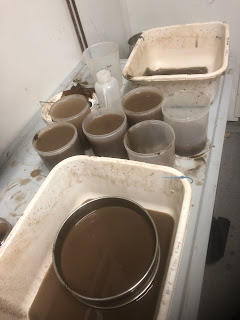Dog and turtle
 |
| Our dirty sieving station - this process involves a lot of mud and even more muddy water. |
"Dog and turtle," she responded right away.
I looked at her quizzically. She looked back at me, even more confused. I showed her the empty white bucket I was holding.
"Oh, empty bucket!" Kharis laughed as she realized what I had really asked. I was trying to tell her we had finished another sample, but she had given me an off-the-cuff honest answer instead. To be fair, I had been throwing seemingly random questions at her over the last hour or so. "Where were you in 2010?" "What would you rather be doing at 12:45 in the morning?" These were my attempts to keep conversation flowing as we worked side-by-side for hours. I suppose a question about her favorite words would not have been out of order. If you can't tell by now, it was late, and we were getting loopy.
The past two days have had perfect weather in Kongsfjorden - like unbelievably perfect. Calm seas, little wind, few clouds. I know how rare a window like this is and how often science is thwarted by weather, especially in the Arctic winter. So when the weather turned perfect, we got busy. A 48-hour sampling marathon.
 |
| A very proud Kharis with her samples (they're in the fume hood because we fixed them in formalin). This photo was taken at 10:15 pm. |
A lot of people sieve mud for science - it's a staple of benthic ecology. What's different about our study is that we're sieving with a much finer mesh, 150 micrometers. That's the same size mesh we use to collect larvae, for the record. It's tiny. We need to sieve that fine so Kharis can find all the newly-settled juveniles she's looking for in her study, but it also means that sieving takes forever.
We had two late nights of sieving in a row, but it was worth it in the end! We collected 4 replicate samples from each of 4 stations, resulting in a solid dataset. If the weather holds, we'll try to get one more station in the uber-shallow part of the fjord, but that's a problem for another day. Right now, we can rejoice over samples safely preserved and a dataset in the bag.
This study is going to be great. Dog and turtle great.
Comments
Post a Comment